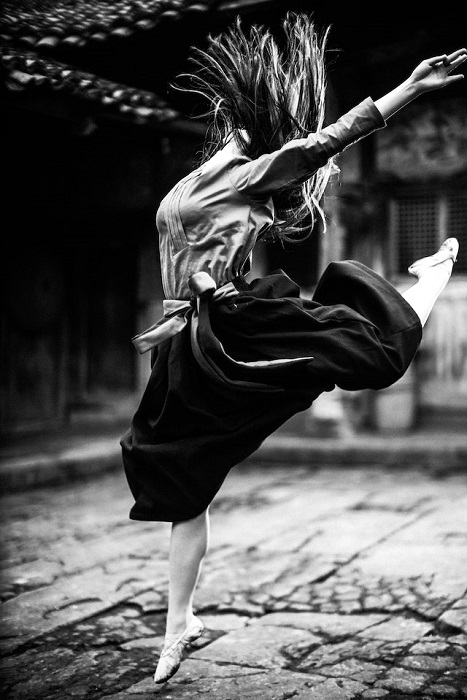
“One does not become enlightened by imagining figures of light, but by making the darkness conscious.” ~ Carl Jung
~
There are moments each month when the darkness in me is so present it scares me.
Sometimes I’m anxious, sometimes depressed. Most of the time, I’m so critical toward myself that I feel like I forgot everything I learned about loving myself over the last few years.
When these moments arise (mostly in my premenstrual phase), I often feel surprised about the force of my feelings.
But I’m never surprised that they exist.
Carl Jung explained that our shadow is the unknown side of our personality:
“Unfortunately, there can be no doubt that man is, on the whole, less good than he imagines himself or wants to be. Everyone carries a shadow, and the less it is embodied in the individual’s conscious life, the blacker and denser it is.“
As a psychologist, I appreciate the limitations that trying to face our shadows mentally has, and I recently became curious how embodying our fears, our darkness, can bring them toward the surface.
So, to explore my own shadow, I decided to dance with it for 30 days.
For a while now, I’ve understood the role that moving our bodies can have when wanting to release stress. But by deciding to dance with my shadow side, I wanted to go deeper and give it the space and attention it deserves. I wanted to honor it.
For this, I was guided by the founder of Qoya, Rochelle Schieck. Qoya is a movement system based on the idea that through movement, we remember, and that the easiest path to our truth is through said movement.
As Rochelle puts it in her instructions, when we dance with our shadow we’re giving the body the opportunity to stop pretending that the darkness isn’t there. Like the day has night, our bright moments have dark ones because light, by its very essence, is only identified against the darkness.
“Can you surrender to your body as it guides you toward wholeness by giving it permission to dance with the shadow?” ~ Rochelle Schieck
As we dance with our shadow, we’re feeling ourselves open for any messages that want to come from the shadow, feeling how the body holds the truth of it all. As we do that, we explore our ability to feel the power of wholeness where we can honor, accept, and look at all parts of self in the eye—even the shadow.
For 30 days, I’d either do a whole Qoya practice that involved a shadow dance, or do only the shadow dance after my regular morning yoga practice. Afterwards, I’d write down what I felt, or any notes I found important in a little journal.
Here’s what I learned:
A range of feelings lives within me. During my dances, a range of emotions came up: sadness, numbness, self-doubt, anger, feeling pulled in all directions, helplessness, feeling small and insignificant, exhaustion, the sense of sleep-walking through life, confusion, tightness, hardness, heaviness, tension, wanting to do more, running away from something, and a closed heart. My guess is that at a certain point in your life, you’ve felt these, too.
Certain topics emerged again and again. The feeling of not being enough, being distracted, feeling disempowered and self-critical, being afraid of rejection, and feeling lonely emerged several times throughout the month. These feelings are already familiar to me, and I now realize that I need to look at them more closely in order to really become friends with myself.
It was easier to tap into the shadow if I first became aware of its opposite. Setting an intention for the movement is something Rochelle asks us in some of her videos. It felt easier to first become aware of the counterpart of the shadow in order to find the shadow itself. To give an example, some of the intentions I set were joy, pleasure, confidence, being present, balance, peace, feeling centered, being intentional, clarity, devotion and commitment, love, ease, and trust. This reminds me of the idea that our feelings are part of a spectrum that we can explore if we’re open to it.
I also realized:
>> On the days I felt resistance to dance with my shadow, I wanted to retreat and be alone. I didn’t feel any desire to be with other people.
>> The difference between thinking, analyzing, and feeling, and that embodying my shadow through dance can be a felt experience.
>> We don’t acknowledge our shadow side so it goes away. We acknowledge it to accept and integrate it as a part of ourselves.
>> There is always a shadow in us. Sometimes we can simply hear it better than other times.
>> There’s a difference between over-identifying with our suffering and acknowledging it as a part of our human experience.
>> The only way to let go of something is to feel, acknowledge, and accept it.
>> My procrastination is the manifestation of not believing in my self.
As I’m writing this, the heaviness of these emotions feels overwhelming. But I clearly remember that as I was dancing them, they felt like a part of me that was allowed to co-exist.
I know that I’m not alone with these feelings, and as much as they are part of my personal experience, they may be part of the human experience in general. Each of us has darkness in us, and it’s our choice if we’re willing to look or not.
Because these 30 days have shown me that I can go from feeling stuck to moving my emotions through my body, I’ll keep incorporating this practice into my movement ritual.
Will you join me?
If you’d like to do a complete Qoya class that includes a shadow dance, check out the two videos below:
To only do the shadow dance (perhaps after another movement practice), you can find videos here, here, or here.
Lastly, find a library of free movement videos here.
I’d love to know in the comments how you feel about your shadow, and if this topic calls you to explore it in a deeper way.
~
Please consider Boosting our authors’ articles in their first week to help them win Elephant’s Ecosystem so they can get paid and write more.
~


 Share on bsky
Share on bsky




Read 33 comments and reply